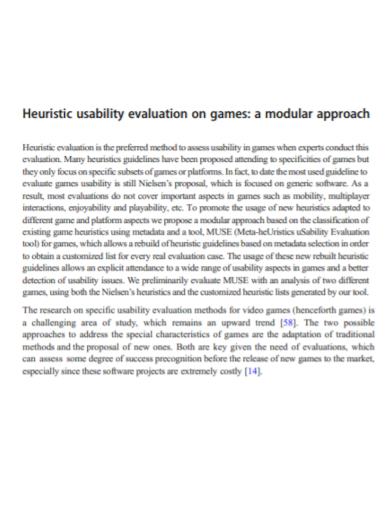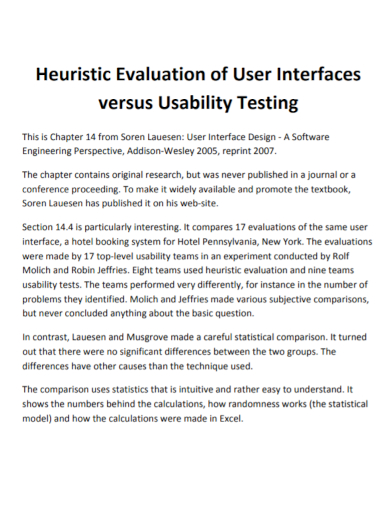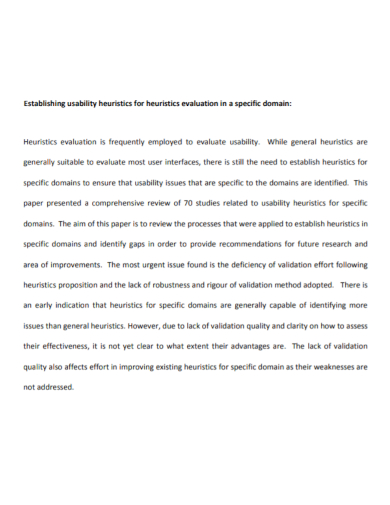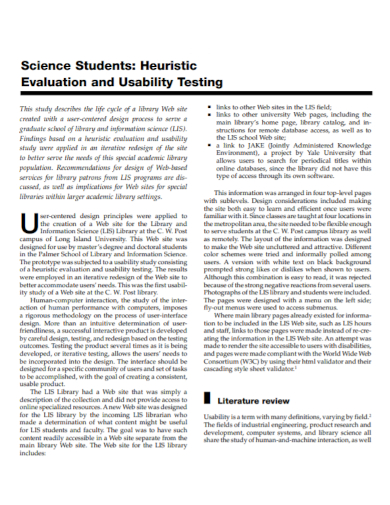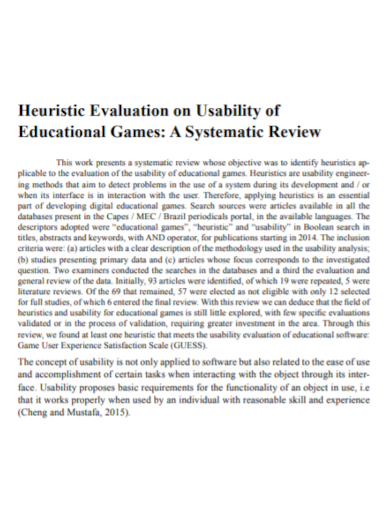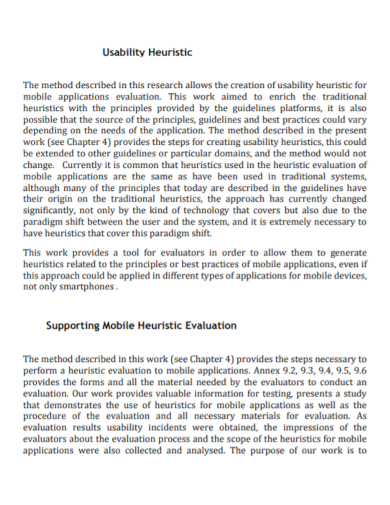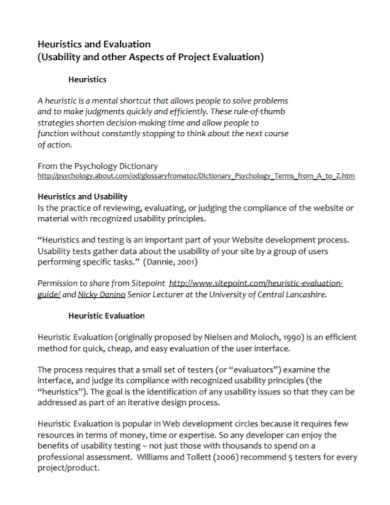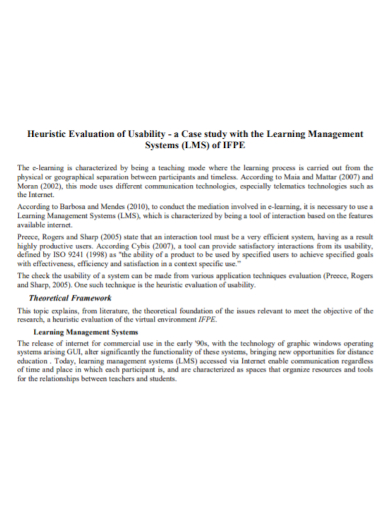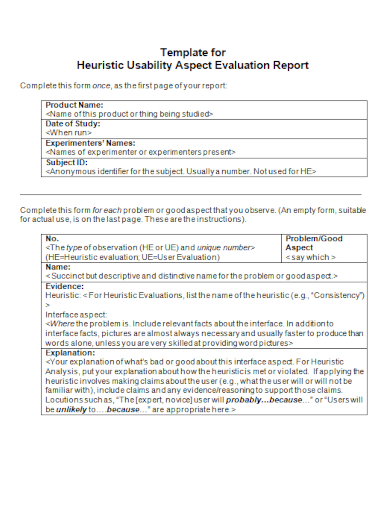Usability testing occurs when experts conduct independent walkthroughs of user interfaces to assess their usability and report any flaws that they discover. Usability testing entails applying rules of thumb to evaluate the usability of user interfaces and reporting any flaws discovered. We evaluate products using well-established heuristics (such as Nielsen- Molich’s) to uncover insights that can be used by design teams to improve the usability of their products from the beginning of the development process. These insights are used by usability experts to assist design teams in improving the usability of their products.
You’ll learn how to perform a heuristic review on every user interface design you encounter in your professional life. You will be able to create and conduct your own heuristic evaluations using the techniques described in this article, allowing you to improve the usability, utility, and desirableness of your designs. To get started, we recommend that you look over the heuristic usability evaluation samples that we’ve included later in this section. You are welcome to use these samples as guides or even templates when writing your own version of the document once you have a feel for it, its appearance, and its functionality.
10+ Heuristic Usability Evaluation Samples
1. Heuristic Mobile Usability Evaluation
2. Heuristic Games Usability Evaluation
3. Heuristic Usability Testing Evaluation
4. Heuristic Usability Domain Evaluation
5. Student Heuristic Usability Evaluation
6. Heuristic Educational Usability Evaluation
7. Mobile Heuristic Usability Evaluation
8. Heuristic Usability Project Evaluation
9. Heuristic Usability Case Study Evaluation
10. Heuristic Usability Design Evaluation
11. Heuristic Usability Aspect Evaluation Report
What Is a Heuristic Usability Evaluation?
A new design trend is to encourage the development of design-specific heuristics that can be used to evaluate products, systems, websites, and other similar endeavors as part of the overall design process. Because of technological advances since Nielsen and Molich developed these heuristics in the 1990s, they are no longer applicable to many of the items on the market. Consider designs for online communities or mobile devices, where the working environment is constantly changing, making Nielsen and Molich’s heuristics inappropriate for evaluating usability. Despite the fact that modern designs have their own set of capabilities and limitations, the original heuristics are still applicable to a large extent today. As a result, as a designer, it is critical that you become proficient in incorporating Nielsen and Molich’s design heuristics into your work as a starting point for your work as soon as possible. Because Nielsen and Molich’s heuristics should not be allowed to become dominant in the process, their ten rules of thumb should be used to inform and inspire designers and businesses to develop specific heuristics, rather than dictating the process with Nielsen and Molich’s heuristics. Market research, other design criteria, and customer needs, combined with the use of your company’s or product’s specific heuristics, will help to improve the suitability of the design under consideration.
How To Write a Heuristic Usability Evaluation
There are no hard and fast rules for how to come up with new heuristics or how to use them because each design has its own set of goals, constraints, functions, styles, and other variables. Because each design has its own set of goals, constraints, functions, styles, and other variables, there are no hard and fast rules that everyone should follow. In heuristic evaluations, they usually only look at five to ten things, which are chosen because they are important to how easy it is to use the system under consideration. When looking for problems and issues, fewer than five criteria may not be strict enough. Using more than ten criteria may be too much for the evaluator, who must keep all of the criteria in mind while reviewing the design. The criteria and heuristics may disagree. To begin, complete and run your own heuristic evaluation by following the steps outlined below.
- Establish an appropriate list of heuristics
Nielsen and Molich’s ten heuristics will assist you in beginning your own creative process. Then, apply Ben Shneiderman’s eight golden rules to begin your own process. To ensure that they work, always combine them with other design guidelines and market research. - Select your evaluators
When selecting evaluators, make certain that they are chosen with care and attention to detail. Users who are not testers should be excluded from the target market. They should typically be usability experts, with a preference for those who are well-versed in the industry in which your product is used, rather than generalists who are not well-versed in that industry. A point-of-sale system for the restaurant industry, for example, should be reviewed by someone who understands how a restaurant operates. - Brief your evaluators
It is critical that they understand what they need to do and cover during their evaluation period in order to perform well on it. Briefing sessions should be consistent to ensure that all assessors receive the same information. Otherwise, you may discover that their assessments are influenced by the information they receive. In this brief, you can request that the evaluators only focus on a specific set of tasks. They can, however, specify which tasks they will cover in this brief based on their own experience and knowledge if any. - First evaluation phase
First, the type and complexity of a product determine how long it takes to complete the initial appraisal. This takes about two hours on average. The evaluators can freely use the product to get a sense of how the project works and how big it is. Following that, they will decide which parts they want to dig deeper into. - Second evaluation phase
During phase two of the evaluation process, the evaluators will apply the heuristics they selected to the items discovered in phase one. Here’s how it works: Aside from individual parts, assessors would consider how well they fit into the overall design. - Record problems
Evaluators must record their own problems, or you should record their problems as they perform their duties so that you can keep track of any issues they encounter. You should document the evaluators’ problems as they work so that you can keep track of any issues that arise. Make sure that when you document problems, the assessors are as clear and thorough as possible. - Debriefing
The debriefing session is a time for the assessors to collaborate and write down their findings in order to create a comprehensive list of problems. They should be encouraged to consider alternative solutions to problems they have encountered by employing the heuristics they have learned.
FAQs
How do you present heuristic findings?
A good heuristic evaluation report should include at least one of the following: Checklists: There are numerous ways to summarize your findings in your report, but using a checklist or grading system can demonstrate how closely the findings have been followed (like a scale of 1 to 10). This will demonstrate how well heuristic standards were followed.
What is a good heuristic evaluation?
Heuristic evaluation is the process by which a small group of people examines an interface and determines whether or not it meets common usability standards.
What are the 3 types of heuristics?
- Availability
- Representativeness
- Anchoring and adjustment
A good heuristic evaluation report should include at least one of the following: Checklists: There are numerous ways to summarize your findings in your report, but using a checklist or grading system can demonstrate how closely the findings have been followed (like a scale of 1 to 10). This will demonstrate how well heuristic standards were followed.
Related Posts
FREE 10+ Sample Speaker Evaluation Forms
FREE 9+ Marketing Evaluation Form Samples
FREE 9+ Interview Evaluation Form Samples
FREE 9+ Event Evaluation Samples
FREE 9+ Sample Performance Evaluation
FREE 8+ Evaluation Plan Templates
FREE 8+ Course Evaluation Forms Samples
FREE 8+ Teacher Evaluation Forms
FREE 7+ Sample Instructor Evaluation Form
FREE 9+ Sample Training Evaluation Forms
FREE 9+ Sample Meeting Evaluation Forms
FREE 9+ Job Evaluation Samples
FREE 9+ Software Evaluation Samples
FREE 9+ Sample Project Evaluation Forms
FREE 7+ Sample Product Evaluation Forms


